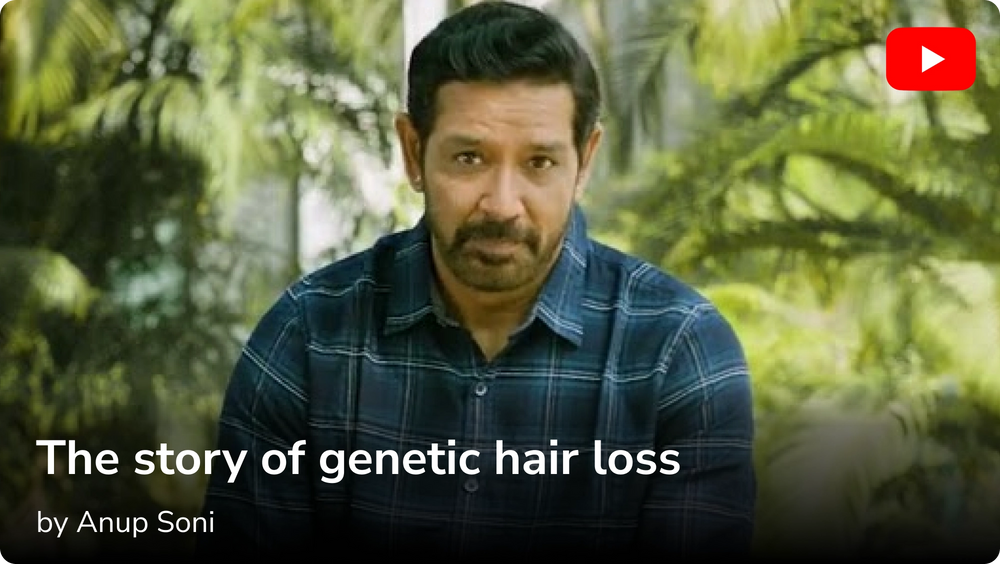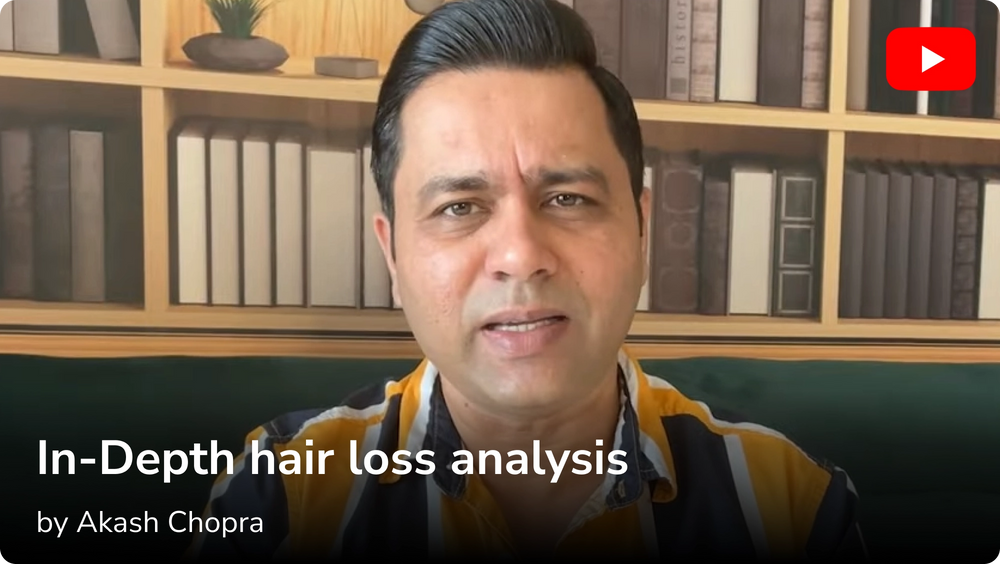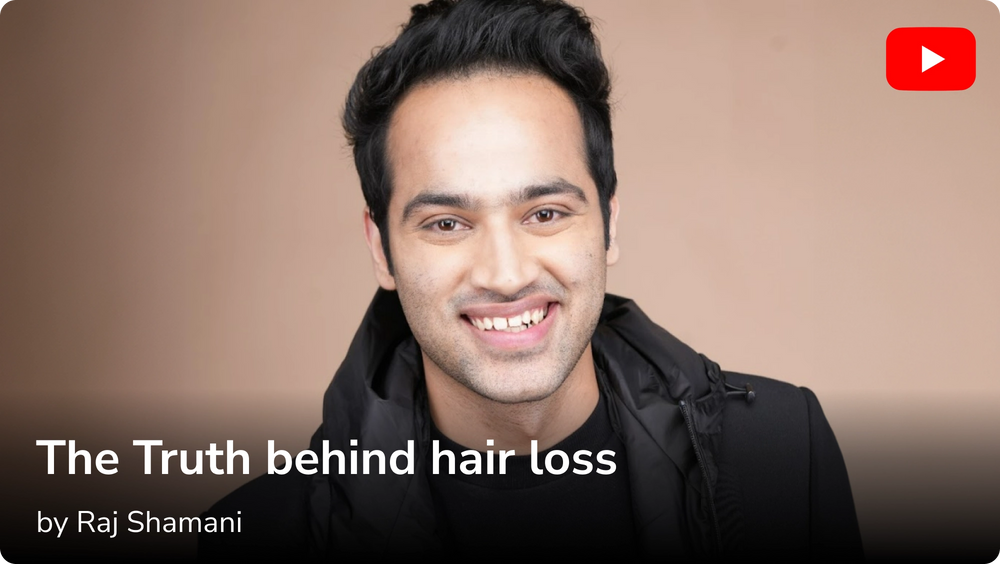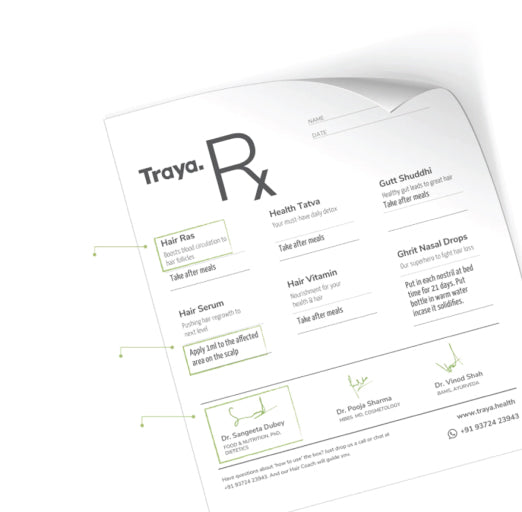Statistically, around 100 strands of hair fall per day is considered normal, but we must say that this number shouldn’t be taken at face value. The thing is, hair fall is different for different people. It could be either just your hair growth cycle working well or a trigger for the onset of hair loss. And in a generation where hair loss is quite common even amongst youngsters, it’s best to look into various possibilities.
Also, do you know if you have hair fall or hair loss? Yes, both can be different. But relax! If you’re unsure of your condition, then you can take the help of Traya’s Free Hair Test and get to know what kind of hair loss you have and what the underlying reason behind it can be.
In this blog, we’ll cover the times your hair loss is normal, when it isn’t, what the possible reasons behind your hair loss can be, and what steps you can take to maintain healthy hair.
Let’s get into it!
How much Hair Fall is Normal?
Typically, hair fall is normal if it is under the range of 50-100 strands, that is what the statistics say. This range is given because hair fall is determined through a lot of factors such as, Seasonal change, Period cycle, Pregnancy, and a lot more.

But we do understand that counting strands is out of the question, then how do you know if your hair fall is normal? Here are some ways to make it out:
1. Only a few strands fall out: So, if you’re taking a head shower, oiling, or combing your hair, then some strands can fall out, but if you see that clusters of hair are coming out, then it can be too much.
2. The scalp isn’t too visible: If you’re noticing widening of the scalp or a receding hair line, then maybe you are losing too much hair. Try taking a picture and then another one after 2 weeks, you’ll be able to see if there is any noticeable difference.
3. Check for Newer Signs: If you’re recently going through too much stress, dandruff, a change in diet, moving cities, or even a change in your lifestyle, then it can affect your hair. You can check with your doctor, and if they suggest getting your blood test done, then you’ll be able to know if you have any deficiencies that may affect your hair health.
4. Hair Length Illusion: When your hair falls out, it could seem a lot due to your hair length. Don’t get scared, and look for other signs, such as hair on the pillow, the floor, or random places where it’s getting noticeable. If by any chance, your hair is getting unmanageable, try trimming it or getting a new haircut; sometimes hair can fall because of split ends (they weaken the hair shaft indirectly), too.
5. Age Factor: Anyone above the age of 35-40, can start experiencing hair loss dues to hormonal shifts, reduction in growth phase, and overall slowed down bodily functions. If taken extra care, then you don’t have to worry about these things, just keep checking your health and look into any nutrtional deficiencies.
6. Genetics: If hair thinning or hair loss runs in the family, you might notice early signs even if your daily care routine has been the same.
We mentioned how hair fall is different from hair loss, and asked which one do you have? In the next section we’ll be covering it, so it may help you understand in depth about what you might be going through.
Hair Fall Vs Hair Loss: What Do You Have?
To put it simply,
Hair fall
Happens when the hair falls out because of the growth cycle.
A Growth Cycle consists of three phases: Anagen (Growth phase), Catagen (Transition phase) , and Telogen (Resting phase). Disruption in any of these phases could trigger hair loss.
Hair loss
Happens when the hair is shedding too much and is causing due to an underlying issue.
Hair loss is a growing problem. At Traya, we have recognized through our studies on Men and Women, that majorly hair loss occurs due to underlying issues. Some of these issues can be:
-
Telogen Effluvium (A temporary condition where more hair follicles enter the resting (telogen) phase due to stress, illness, or sudden lifestyle changes. It often follows events like surgery, pregnancy, or a high fever.)
-
Androgenetic Alopecia (Male or Female Pattern Baldness)
-
Nutritional Deficiencies
-
Hormonal Imbalances
-
Stress
-
Autoimmune Conditions (Immune system attacks hair follicles causing patchy hair loss)
-
Medications and Treatments
These conditions usually go unnoticed until its effects show visibly, it is best to remain cautious and maintain a standard practice o having regular check ups to avoid health issues.
How to Maintain Healthy Hair?
Hair sheds all the time, but its frequence and amount can be stabilized by making changes to your daily routine, here are some suggestions:
1. Daily Hair Care Routine
Opt for Mild Shampoo and Conditioner:
Harsh chemicals, such as sulfates, parabens, formaldehyde, phthalates, and silicones, Fragrances, Alcohol, Polyethylene glycol, Dimethicone, Propylene glycol, Colorantsn, Diethanolamine, can cause the natural oils of your scalp to strip away and sometimes even cause dryness. Its best to go for moisturizing or mild shampoos.
Refrain from Over Washing:
People sometimes over wash hair due to having greasy hair, putting too much oil, or just because hair looks good after washing. But trust us, in the long run, too much hair wash can cause scalp issues and then affect hair follicles. It is best to to only wash 2-3 times a week.
Be Gentle When Brushing:
You must have heard how wet hair is prone to breakage, and causes more hair fall. Don’t worry, if you’re a person having curly hair, and have to maintain your hair without damaging your routine, then take steps to build you scalp stronger. Such as: Regular oiling for nourishment, applying natural hair masks, and staying hydrated along with having a good diet will greatly help.
2. Dietary Improvements
Most of our users have suffered hair loss due to digestion problems and nutrient deficient diet. Here’s what you can add to your diet to make it perfect for your overall health which can help hair too.
Protein-Rich Foods:
Protein is not limited to gym goers. They do have it in addition, but people should normally and naturally incorporate protein into their diets.
Hair is primarily made of keratin, a protein, so it’s essential to consume enough protein in your diet. Including lean meats, eggs, beans, and nuts can support hair growth.
Omega-3 Fatty Acids:
Omega-3s like salmon, flaxseeds, and walnuts helps with hair growth. These fatty acids nourish the scalp and help maintain healthy hair. If these foods are not what you usually eat and have a hard time including them into your diet, then try visiting your doctor and if they recommend supplements, then you can have them too.
Vitamins for Hair Health:
Try including vitamins A, E, and D, these vitamins are important for achieving healthy scalp and hair. You can include foods like, sweet potatoes, spinach, and eggs, these are rather good sources.
Iron-Rich Foods:
Iron is a component present in hoemoglobing, it helps carry oxygen to your hair follicles. This process helps having healthy hair growth, as a lot of women have anaemia, it becomes crucial to include iron rich foods in the diet. You can include foods like spinach, lentils, red meat, and fortified cereals in your meals.
Scalp Care
Having external care is as important as having internal care. You diet could be great, but of you have heavy dandruff, then you might suffer from hair loss as well.
Try to have a scalp care routine once a while, it doesn’t have to be a salon treatment, you could use natural hair masks, and remedies, the ingredients present in the masks can help with providing nourishment to your hair.
Stress Management
Life is stressful. From students to working individuals, all go through stress. But we must understand, that constant stress is harmful internally which shows its signs externally, through dry hair, dull skin, bloating, and much more.
Even if you have too much on your plate, it’s best to include stress relieving practices even for 10-20 minutes. Try doing yoga, light exercises, and even going out on a walk would do.
Doctor Recommended Products
Traya Defence Shampoo: Traya defence shampoo is made with mild ingredients which are, Biotin, Vitamin B3, Hydrolyzed wheat protein, Pisum Sativum Sprout Extract (Pea Protein)-Anagain, Citric Acid. These ingredients are selected to help you have a gentle wash while providing nourishment. It supports hair growth by reducing oxidative stress in hair cells with the help of well-tested ingredients. It is a mild cleansing formula which works on removing the dirt & maintaining an ideal scalp pH.
Traya Hair Vitamins: Traya has formulated hair vitamins that have dht blockers. These Dht blockers usually have some side effects for women, hence we have also formulated Hair Vitamins for Her. These vitamins help provide internal nourishment, boost keratin, and help achieving stronger hair.
Traya Recap Hair Growth Serum: The ReCaP Serum is formulated with Redensyl 3%, Capixyl 5%, Procapil 3%. These ingredients are dermatologically tested and are often used in our treatment plans for users experiencing hair widening or a receding hair line. It works on hair loss by restricting the effect of DHT on the hair follicles, which can cause poor follicle development, hair thinning, and reduced hair growth.
All of the above mentioned products are often recommended to our users by the doctor in their holistic treatment plans. So, if you’re someone who requires guidance along with well-tested treatment then here’s how Traya can help you.
How Can Traya Help?
Traya is a research and clinically-backed hair treatment solution. At Traya, we use the threefold method of including, Ayurveda, Dermatology, and Nutrition to create a personalized holistic treatment for our users.
We can help you in your hair care journey by giving ongoing hair treatment assistance, providing diet plans, setting up scalp tracker, and a doctor prescribed kit every month till you achieve you hair health goals.
Take the first step by filling the free hair test today, and get the root cause diagnosis results in 5 minutes.
People Also Ask
Q. Is 200 hair stands hairfall a day normal?
No, shedding 200 hair strands a day is not considered normal. On average hair fall ranges from 50-100 hair strands per day being it's a part of the hair growth cycle, if you're shedding 200+ hair a day, then there is a chance you might have hair loss issues. You can consult by taking traya's hair test and see what the root cause can be of your hair loss.
Q. How do I know if I'm losing too much hair?
You can identify hair loss through many signs like flaky scalp, thinner pony tail, scalp widening, receding hairline, or bald patches. If any of these conditions too prominent then maybe you are going through hair loss and should consult a professional.
Q. How much hair is OK to fall?
Losing around 50-100 hair per day is considered to be normal as it's a part of the hair growth cycle, even up to 150 is alright but more than 150 raises some concerns and you should get it consulted by a professional.
Q. Is it okay to lose 500 hairs a day?
No, losing 500 hair strands in a day is considered to be severe hairloss and you should start taking precautionary steps, if you're concerned about your hairloss then try contacting a hair care professional or take traya's free hair test to identify the root cause of your hair problems.
References
Androgenetic Alopecia | https://www.ncbi.nlm.nih.gov
Diet and hair loss: effects of nutrient deficiency and supplement use| https://pmc.ncbi.nlm.nih.gov
Hair Fall: Common Causes and Treatment Modalities | https://www.researchgate.net




















